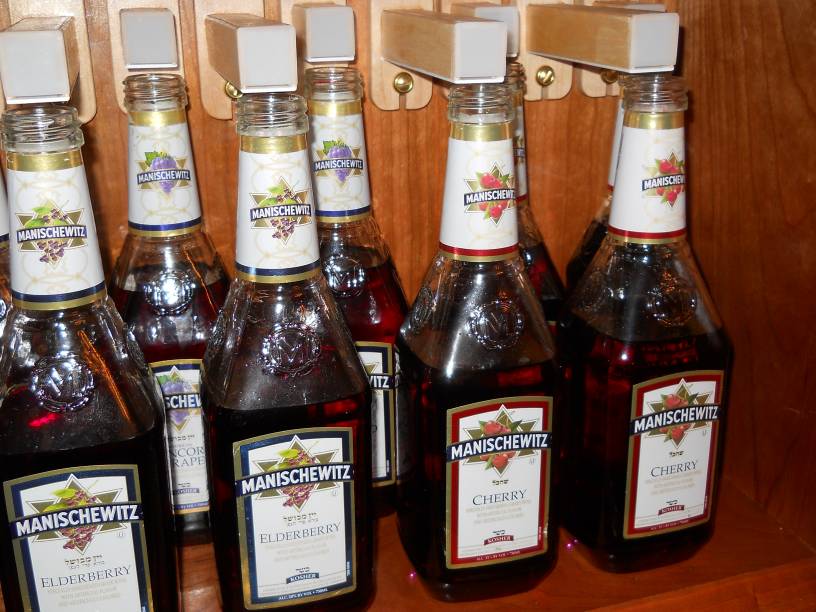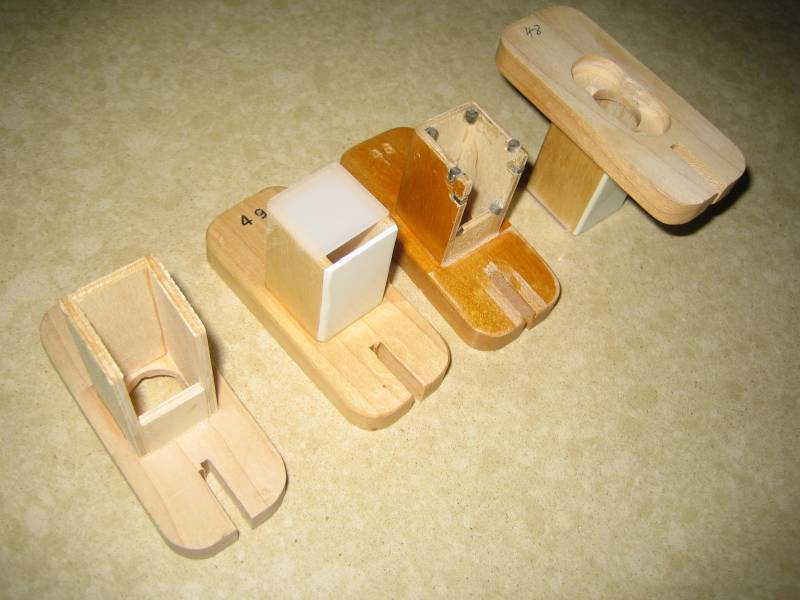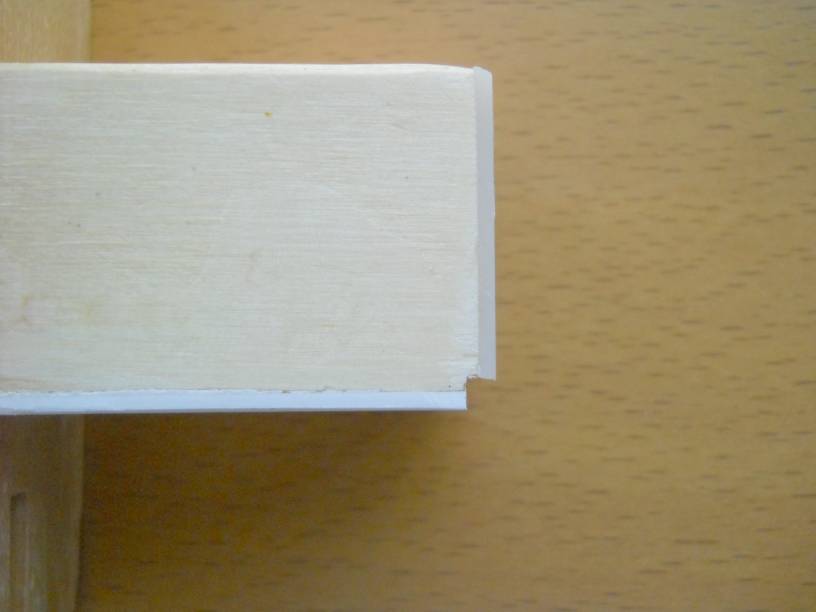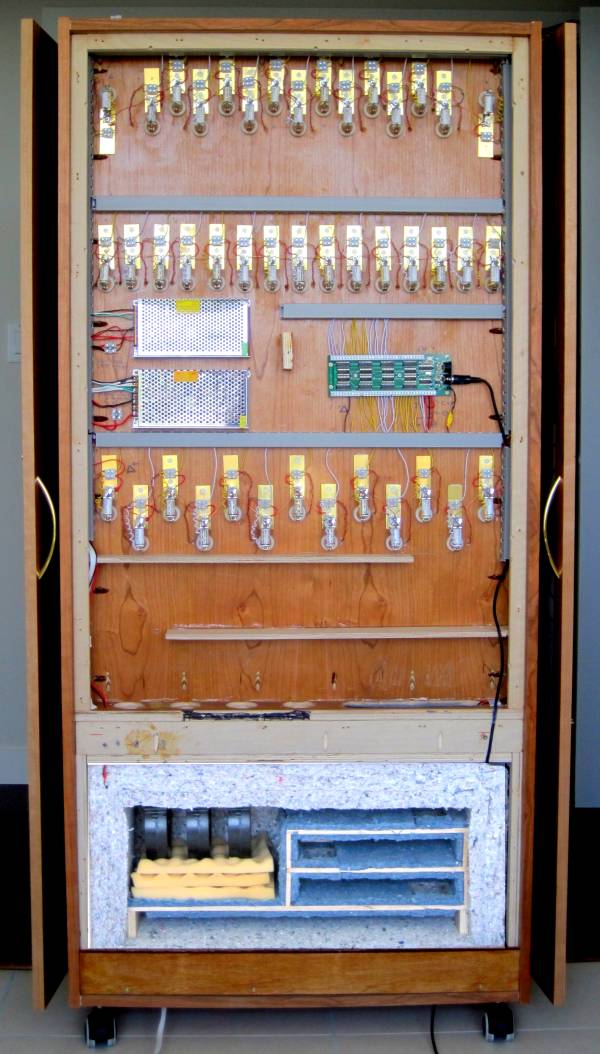| You Are Not Logged In | Login/Get New Account |
|
Please Log In. Accounts are free!
Logged In users are granted additional features including a more current version of the Archives and a simplified process for submitting articles. |
|
MMD
 Gallery
Gallery
 Tech
Tech
 PDayson
PDayson
 dayson1
dayson1
|
|
by Phil Dayson (120828 MMDigest) Introduction After a very long time I have finally finished the "Manischewitz Wine Bottle Organ". Here are some technical details of the bottle organ that I have built. An audio clip giving a few seconds of many tunes is included here. Except for the first tune, all of the arrangement were by David Leach for a 45-note organ. snippets.mp3 (5,273 kb) David Leach, arr. Video clips have also been posted on YouTube at http://www.youtube.com/watch?v=XDSDdy8-w80
Colonel Bogey - march
General Firstly some advice for anyone planning on building a bottle organ: try to select bottles according to the "robustness" of the sound produced upon testing -- this is particularly true for the higher notes. I selected bottles only of one brand & shape & appearance. This may have made a more cosmetically attractive organ but it may well have compromised the tone quality of the final result. Scale The organ plays MIDI notes 46 to 88 inclusive (43 notes total) beginning on B-flat below "tenor C", which is seven notes lower pitch than the Tangley calliope. Wind pressure & blower All the bottles seem to blow well between pressures of about 0.75 inch water gauge and 1.5 inch water gauge. I ended up using about 0.9" water gauge pressure. Since I did not want the complication of building a pressure regulator, I selected blowers that have a flat flow vs. pressure curve. I ended up using three small blowers running in parallel so that I could blow eight notes or even more simultaneously with little change in pressure. I found these cheap surplus units that met the criteria: JAPAN SERVO Model E1540H24
Tech data sheet: nidec-servo-E1540H.pdf (281 kb) Two blowers probably would been sufficient but they were so cheap and I had lots of room. In any case one of the beauties of bottle blowing is that the pressure has little effect on the tuning. It seems to change the sound volume a little but not the tuning. The final decided pressure was achieved by putting in some small resistors in series with the fans and the 24 v power supply. The blowers were built into the bottom of the organ case. See photo below. To minimize noise the air input to the fan was directed via a labyrinth duct lined with acoustic cotton. Bottles To prevent evaporation and subsequent loss of tuning mineral oil was used in all the bottles. The oil was colored with an oil based dye. For tuning I downloaded a free app for the android phone DaTuner Accurate and works like a charm. Electronics I used 1-1/8" pallet valves from Peterson Electro-Musical Products, Inc. and a MIDI decoder from j-Omega Electronics. I have used both of these items in many projects without problem. In an attempt to reduce the "sound board" noise from the operation of the solenoids I mounted each solenoid on a strip of metal then attached this assembly to the organ case with double sided foam tape. Nozzles The heart of the bottle organ is the blowing nozzle. I spent many many hours trying various designs with different internal and external configurations, not too dissimilar to the Peterson organs. I ended up using a simple nozzle in the form a square tube with a horizontal slit on the end. The nozzle is screwed to the organ case but can be moved up and down to get the best sound with the least wind noise. The bottles can be moved in and out and are located against a simple wood screw. The nozzles are about 3/4" square with the top and sides made from 1/8 plywood. The end and the underside are 1/16 plastic. The nozzle gap is determined by the space between the end and the underside pieces. By adjusting both of these pieces the gap width AND the direction of air flow can be modified. It is really a question of trial and error to get the best dimensions and the location of the nozzles relative to the bottles. Most the gaps seem to run between 1/8" and 1/16" -- larger gap for the large bottles and smaller gap for the smaller bottles. Shown in the photos is a complete nozzle and a nozzle without the end and bottom.
Also shown is a special nozzle I built for trial and error testing. Small 1/8" diameter magnets were glued to wood. For testing this allowed end and bottom pieces made of thin steel to be attached to the nozzle body to create a gap both variable in size and size and direction. There is also a side view photo of a nozzle showing how the gap is created by the end and bottom pieces. I did notice one curious phenomenon with the high notes. There appeared to be two different nozzle locations which could blow the bottle. One location would give a quieter sound with little air noise. The other a much louder sound but with a lot of air noise. The nozzle design for these high notes probably needs some tweaking but at this time it is another job for the future! This was a fun project even though it took me a very long time to build. I am very pleased with the final result but was certainly helped by some super arrangements by David Leach, an organ builder in England The Kramer Patent Some substantial time after the organ was finished I discovered a US patent taken out by Justin Kramer. A link to a PDF copy of the patent is below. Justin Kramer was a California organ builder who built a bottle organ which he called Jugorgel. Kramer showed the Jugorgel on the Johnny Carson TV show in 1973. It was apparently one of the inspirations for the Peterson bottle organ years later. In contrast to the Kramer design, the Peterson Company (as I have done) avoided attaching the blowing nozzle to the bottle but rather attached it to to the organ case. I believe it makes for a much more attractive and versatile setup. The patent is quite interesting and it confirms the difficulties that are encountered in the bottle blowing of high pitched notes. Kramer gives some nozzle designs to overcome this difficulty but I have yet to try any of his designs. US3748945.pdf (211 kb) Phil Dayson
31 Aug 2012 19:36:36 -0700 |
|
|
|
|
|
|
|
|
|
CONTACT FORM: Click HERE to write to the editor, or to post a message about Mechanical Musical Instruments to the MMD Unless otherwise noted, all opinions are those of the individual authors and may not represent those of the editors. Compilation copyright 1995-2026 by Jody Kravitz. Please read our Republication Policy before copying information from or creating links to this web site. Click HERE to contact the webmaster regarding problems with the website. |
|
|
||||||
|





